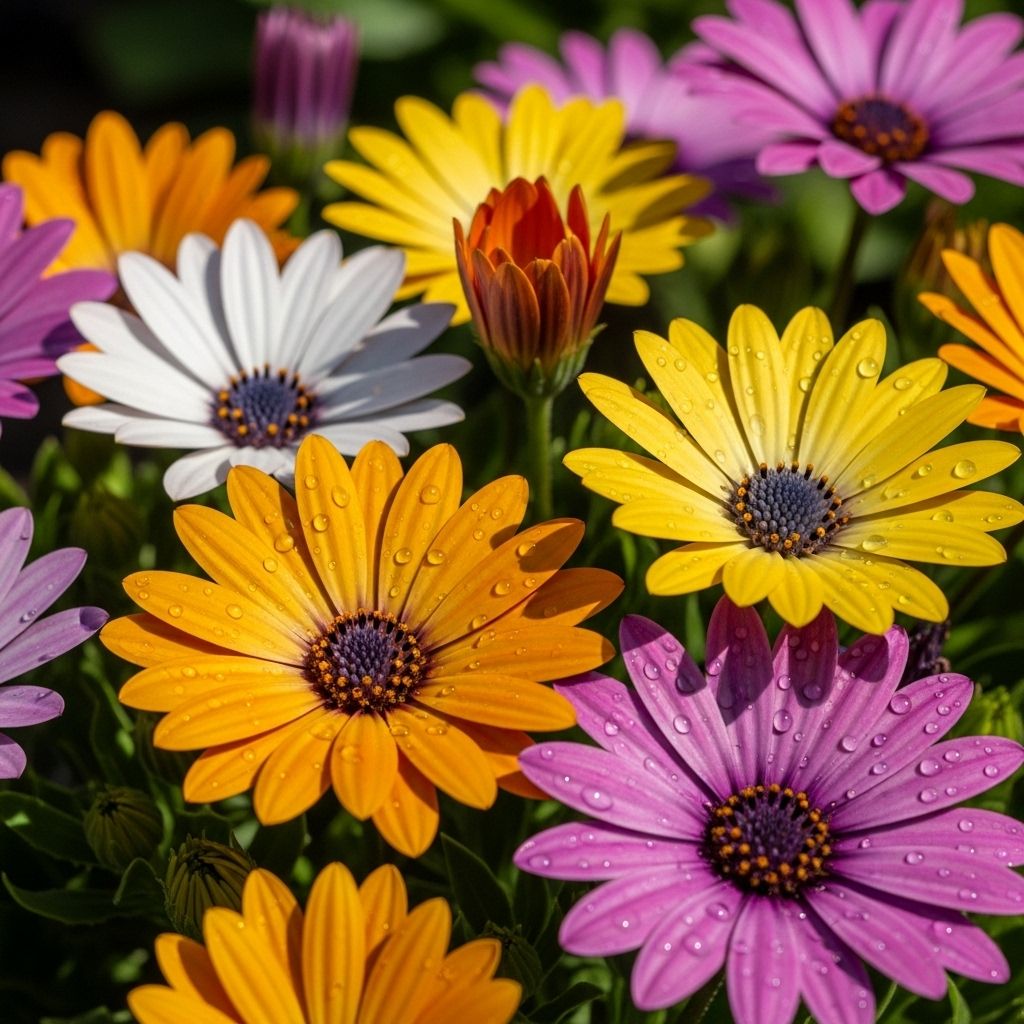African Daisy Care: Essential Guide For Colorful Blooms
Discover how to grow and care for these sun-loving, drought-tolerant flowering plants that bring vibrant color to your garden

Image: HearthJunction Design Team
All About African Daisies: The Colorful Garden Stars
African daisies (Osteospermum) bring vibrant splashes of color to gardens with their daisy-like flowers in stunning hues ranging from white and cream to purple, pink, yellow, and orange. These eye-catching plants are beloved for their profuse blooming habit and relatively easy care requirements, making them excellent choices for gardeners of all experience levels.
Native to South Africa, these members of the Asteraceae family have become popular garden additions worldwide thanks to their drought tolerance and impressive flowering performance. Whether planted in borders, containers, or mass plantings, African daisies deliver significant visual impact with minimal fuss.
African Daisy Plant Profile
Before diving into care specifics, understanding the basic characteristics of African daisies will help you successfully incorporate them into your garden design:
- Botanical Name: Osteospermum (several species and numerous hybrids)
- Common Names: African daisy, Cape daisy, Blue-eyed daisy
- Plant Type: Perennial in zones 9-11; grown as an annual in colder regions
- Bloom Time: Spring through fall, with peaks in late spring/early summer and again in late summer/early fall
- Mature Size: Typically 1-3 feet tall and 1-2 feet wide, depending on variety
- Sun Exposure: Full sun to partial shade (minimum 6 hours direct sunlight daily)
- Soil Type: Well-draining soil; tolerates poor soils
- Soil pH: Slightly acidic to neutral (6.0-7.0)
- Hardiness Zones: USDA zones 9-11 as perennials; grown as annuals elsewhere
Growing African Daisies Successfully
Light Requirements
African daisies are sun-worshippers that require at least 6 hours of direct sunlight daily to thrive and produce abundant blooms. Their flowers actually respond to sunlight, opening fully during daylight hours and closing at dusk or during cloudy conditions. In hotter climates, they may benefit from some afternoon shade, which can help extend their blooming period during intense summer heat.
For container plantings, position your African daisies in a spot that receives morning sun but offers some protection from harsh afternoon rays, especially in regions with scorching summers. This balance of sun exposure helps maintain continuous blooming while preventing stress from excessive heat.
Soil Requirements
One of the greatest attributes of African daisies is their adaptability to various soil conditions, though they perform best in well-draining soil. Heavy clay soils can lead to root rot and other moisture-related problems, so if your garden has clay soil, consider amending it with compost, sand, or other materials to improve drainage.
These plants prefer slightly acidic to neutral soil pH (6.0-7.0), but they’re not particularly fussy. Before planting, incorporate some organic matter into your soil to provide nutrients and improve structure. For container plantings, use a high-quality, well-draining potting mix formulated for flowering plants.
Watering African Daisies
Once established, African daisies display impressive drought tolerance, making them excellent choices for water-wise gardens. However, for optimal growth and flowering, they should receive approximately 1 inch of water per week from rainfall or irrigation. The golden rule when watering African daisies is to keep the soil evenly moist but never soggy.
Allow the soil surface to dry between waterings to prevent root rot and other moisture-related diseases. During periods of extreme heat or drought, you may need to increase watering frequency, but be mindful not to overwater. In containers, African daisies will require more frequent watering than those planted in the ground, as potting soil dries out faster.
During periods of intense summer heat, African daisies may go dormant and stop blooming temporarily. This is a natural survival mechanism and not cause for concern. Maintain regular watering during these periods, and the plants will likely resume flowering when temperatures moderate.
Temperature and Climate Considerations
African daisies prefer mild temperatures and produce their most impressive floral displays during spring and fall when days are warm but not scorching. They can tolerate nighttime temperatures down to about 40°F (4°C), but frost will damage or kill them outright.
In regions with hot summers, flowering may slow or stop during the peak heat of July and August, resuming again when temperatures cool in early fall. This temporary dormancy is normal and doesn’t indicate a problem with the plants. In frost-prone areas (zones 8 and below), African daisies are grown as annuals or overwintered indoors.
Seasonal African Daisy Care
Spring Care
Spring marks the beginning of the active growing season for African daisies. If you’re planting new specimens, wait until after the last frost date in your area. Space plants 12-18 inches apart to allow for proper air circulation. For established plants coming out of winter (in warmer zones), this is the time to:
- Apply a balanced, slow-release fertilizer to promote strong growth and abundant blooms
- Prune away any winter damage and shape plants as needed
- Monitor for early-season pests like aphids and address promptly
- Mulch around plants to retain moisture and suppress weeds
Summer Maintenance
During summer, focus on maintaining consistent moisture while accepting that blooming may decrease during intense heat periods:
- Water deeply when the soil surface feels dry, especially during drought conditions
- Deadhead spent blooms regularly to encourage continued flowering
- Provide some afternoon shade in very hot regions to reduce heat stress
- Consider a light trim by midsummer if plants become leggy, which can rejuvenate growth
- Continue monitoring for pests and diseases, particularly during humid weather
Fall Care
As temperatures cool in early fall, African daisies often enjoy a second major flowering period:
- Reduce fertilization as the growing season winds down
- Continue deadheading to maximize fall blooming
- In zones 9-11, prepare perennial plants for winter by reducing watering slightly
- In colder regions, take cuttings before frost if you wish to propagate plants for next year
Winter Protection
In zones 9-11 where African daisies grow as perennials:
- Apply a layer of mulch around the base of plants to protect roots
- Reduce watering frequency during the dormant period
- Protect from unexpected frost with covers if necessary
In colder regions (zones 8 and below), either treat African daisies as annuals or bring container plants indoors to a cool, bright location for overwintering.
Fertilizing for Optimal Blooms
African daisies benefit from regular fertilization throughout their growing season. At planting time, incorporate a slow-release fertilizer into the soil. During the active growing season (spring through fall), supplement with monthly applications of a balanced fertilizer formulated for flowering plants.
Be cautious not to over-fertilize, particularly with nitrogen-heavy products, as this can promote lush foliage at the expense of flower production. Always water thoroughly after fertilizing to prevent root burn and to help nutrients reach the root zone.
Pruning and Maintenance
Regular maintenance keeps African daisies looking their best and promotes continuous blooming:
Deadheading
Perhaps the most important maintenance task for African daisies is deadheading—removing spent blooms before they set seed. This simple practice redirects the plant’s energy from seed production back to flower production, ensuring longer bloom periods. Simply pinch or snip off faded flowers at the stem base.
Shaping and Pinching
Early in the growing season, pinching young plants two or three times helps create fuller, bushier growth and stronger stems. Simply remove the top inch of new growth using your fingers or clean scissors. By midsummer, African daisies can become somewhat leggy. A light trim at this time (removing about one-third of the growth) can rejuvenate the plants and stimulate fresh flowering.
Propagation Methods
There are several effective ways to propagate African daisies:
From Seeds
Start seeds indoors 8-10 weeks before the last expected frost. Sow seeds on the surface of seed-starting mix and press lightly—don’t cover, as they need light to germinate. Keep soil consistently moist until germination occurs, typically within 10-14 days at temperatures between 65-75°F (18-24°C).
From Cuttings
Take 3-4 inch stem cuttings in late summer or early fall. Remove lower leaves and dip the cut end in rooting hormone if desired. Plant in a well-draining rooting medium and keep consistently moist until roots develop, usually within 2-3 weeks. This method is particularly useful for overwintering favorite varieties in colder climates.
By Division
In zones where African daisies grow as perennials, established plants can be divided in early spring. Dig up the entire plant, separate the root ball into sections ensuring each has stems and roots, and replant immediately.
Common Pests and Problems
While relatively trouble-free, African daisies can occasionally face challenges:
Pest Issues
- Aphids: These small sap-sucking insects can cluster on new growth. Control with insecticidal soap or a strong spray of water.
- Spider Mites: More common during hot, dry conditions, these tiny pests cause stippled yellowing on leaves. Increase humidity around plants and treat with appropriate miticides if necessary.
- Slugs and Snails: These can damage young plants and leaves, especially in damp conditions. Use appropriate baits or traps.
Disease Concerns
- Powdery Mildew: This fungal disease appears as a white powder on leaves, typically in humid conditions with poor air circulation. Improve airflow around plants and avoid overhead watering.
- Root Rot: Caused by overwatering or poorly draining soil, symptoms include wilting despite moist soil and blackened roots. Prevention through proper watering practices is key.
- Viral Diseases: These may cause mottled leaves or stunted growth. Remove and destroy affected plants to prevent spread.
Landscape Uses
The versatility of African daisies makes them valuable additions to various garden settings:
- Border Plantings: Their medium height works well in the middle of mixed borders
- Container Gardens: Excellent as focal points or companions in pots and planters
- Mass Plantings: Create dramatic color impact when grouped together
- Rock Gardens: Their drought tolerance makes them suitable for these settings
- Butterfly Gardens: Their bright blooms attract beneficial pollinators
For best visual impact, combine African daisies with plants that maintain interest during the hottest part of summer when daisies may temporarily slow their blooming.
Frequently Asked Questions (FAQs)
Q: Why have my African daisies stopped flowering in midsummer?
A: African daisies typically slow or stop blooming during periods of intense summer heat. This is a natural response and not cause for concern. Maintain regular watering and the plants should resume flowering when temperatures moderate in late summer or early fall.
Q: Can African daisies survive winter in cold climates?
A: In USDA zones 8 and below, African daisies are not winter-hardy and are typically grown as annuals. However, you can take cuttings in fall before frost to propagate new plants indoors for the following spring, or in some cases, bring potted specimens inside for the winter.
Q: How often should I fertilize my African daisies?
A: For best results, apply a slow-release fertilizer at planting time, followed by monthly applications of a balanced fertilizer formulated for flowering plants during the active growing season (spring through fall).
Q: Do African daisies attract butterflies and bees?
A: Yes, African daisies are attractive to various pollinators, including butterflies, bees, and other beneficial insects, making them valuable additions to wildlife-friendly gardens.
Q: Why do African daisy flowers close at night?
A: African daisy flowers exhibit nyctinasty, a response to light changes that causes blooms to open in daylight and close at night or during cloudy conditions. This is a natural characteristic of the plant and actually adds to its charm and interest in the garden.
References
- https://www.thespruce.com/growing-and-caring-for-african-daisies-1402912
- https://www.masterclass.com/articles/african-daisy-guide
- https://plantologyusa.com/blogs/the-plantologist/african-daisy-care-guide
- https://www.bhg.com/gardening/plant-dictionary/annual/african-daisy/
- https://plantaddicts.com/african-daisy-care/
Read full bio of Shinta












